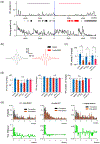NMDA receptors promote hippocampal sharp-wave ripples and the associated coactivity of CA1 pyramidal cells
- PMID: 33112474
- PMCID: PMC8645203
- DOI: 10.1002/hipo.23276
NMDA receptors promote hippocampal sharp-wave ripples and the associated coactivity of CA1 pyramidal cells
Abstract
Hippocampal sharp-wave ripples (SWRs) support the reactivation of memory representations, relaying information to neocortex during "offline" and sleep-dependent memory consolidation. While blockade of NMDA receptors (NMDAR) is known to affect both learning and subsequent consolidation, the specific contributions of NMDAR activation to SWR-associated activity remain unclear. Here, we combine biophysical modeling with in vivo local field potential (LFP) and unit recording to quantify changes in SWR dynamics following inactivation of NMDAR. In a biophysical model of CA3-CA1 SWR activity, we find that NMDAR removal leads to reduced SWR density, but spares SWR properties such as duration, cell recruitment and ripple frequency. These predictions are confirmed by experiments in which NMDAR-mediated transmission in rats was inhibited using three different NMDAR antagonists, while recording dorsal CA1 LFP. In the model, loss of NMDAR-mediated conductances also induced a reduction in the proportion of cell pairs that co-activate significantly above chance across multiple events. Again, this prediction is corroborated by dorsal CA1 single-unit recordings, where the NMDAR blocker ketamine disrupted correlated spiking during SWR. Our results are consistent with a framework in which NMDA receptors both promote activation of SWR events and organize SWR-associated spiking content. This suggests that, while SWR are short-lived events emerging in fast excitatory-inhibitory networks, slower network components including NMDAR-mediated currents contribute to ripple density and promote consistency in the spiking content across ripples, underpinning mechanisms for fine-tuning of memory consolidation processes.
Keywords: NMDA receptors; computational model; sharp-wave ripples; spindles.
© 2020 Wiley Periodicals LLC.
Conflict of interest statement
CONFLICT OF INTEREST
The authors declare no conflict of interest.
Figures





Similar articles
-
Dentate Gyrus Sharp Waves, a Local Field Potential Correlate of Learning in the Dentate Gyrus of Mice.J Neurosci. 2020 Sep 9;40(37):7105-7118. doi: 10.1523/JNEUROSCI.2275-19.2020. Epub 2020 Aug 19. J Neurosci. 2020. PMID: 32817247 Free PMC article.
-
Disrupted hippocampal sharp-wave ripple-associated spike dynamics in a transgenic mouse model of dementia.J Physiol. 2016 Aug 15;594(16):4615-30. doi: 10.1113/jphysiol.2014.282889. Epub 2015 Jan 2. J Physiol. 2016. PMID: 25480798 Free PMC article.
-
Reorganization of CA1 dendritic dynamics by hippocampal sharp-wave ripples during learning.Neuron. 2022 Mar 16;110(6):977-991.e4. doi: 10.1016/j.neuron.2021.12.017. Epub 2022 Jan 17. Neuron. 2022. PMID: 35041805 Free PMC article.
-
Ripples make waves: binding structured activity and plasticity in hippocampal networks.Neural Plast. 2011;2011:960389. doi: 10.1155/2011/960389. Epub 2011 Sep 27. Neural Plast. 2011. PMID: 21961073 Free PMC article. Review.
-
Progress on the hippocampal circuits and functions based on sharp wave ripples.Brain Res Bull. 2023 Aug;200:110695. doi: 10.1016/j.brainresbull.2023.110695. Epub 2023 Jun 21. Brain Res Bull. 2023. PMID: 37353037 Review.
Cited by
-
Single closed-loop acoustic stimulation targeting memory consolidation suppressed hippocampal ripple and thalamo-cortical spindle activity in mice.Eur J Neurosci. 2024 Feb;59(4):595-612. doi: 10.1111/ejn.16116. Epub 2023 Aug 21. Eur J Neurosci. 2024. PMID: 37605315 Free PMC article.
-
Rescue of sharp wave-ripples and prevention of network hyperexcitability in the ventral but not the dorsal hippocampus of a rat model of fragile X syndrome.Front Cell Neurosci. 2023 Dec 1;17:1296235. doi: 10.3389/fncel.2023.1296235. eCollection 2023. Front Cell Neurosci. 2023. PMID: 38107412 Free PMC article.
-
Ascorbic Acid Reduces Neurotransmission, Synaptic Plasticity, and Spontaneous Hippocampal Rhythms in In Vitro Slices.Nutrients. 2022 Jan 30;14(3):613. doi: 10.3390/nu14030613. Nutrients. 2022. PMID: 35276972 Free PMC article.
-
Examining the low-voltage fast seizure-onset and its response to optogenetic stimulation in a biophysical network model of the hippocampus.Cogn Neurodyn. 2024 Feb;18(1):265-282. doi: 10.1007/s11571-023-09935-1. Epub 2023 Feb 10. Cogn Neurodyn. 2024. PMID: 38406204 Free PMC article.
References
Publication types
MeSH terms
Substances
Grants and funding
LinkOut - more resources
Full Text Sources
Miscellaneous

